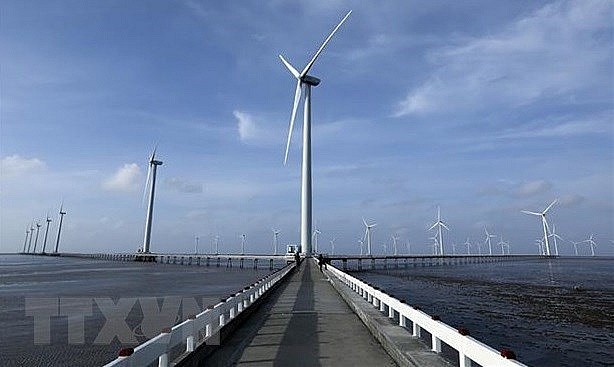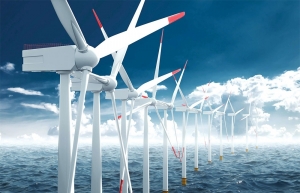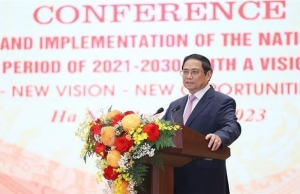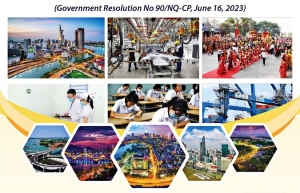National energy master plan for 2021-2030 approved
 |
| The Bac Lieu wind power plant has 62 power turbines with a total estimated capacity of 99MW. (Photo: VNA) |
Hanoi - Deputy Prime Minister Tran Hong Ha has freshly signed a decision to approve the national energy master plan for the 2021-2030 period, with a vision to 2050.
The overall objective of the plan is to ensure the country's energy security, meet the requirements of economic and social developments, industrialisation and modernisation, ensure national defence and security, improve the people's living standards, and protect the ecological environment. In addition, it aims to develop an independent and autonomous energy industry, and establish a comprehensive energy industry ecosystem based on renewable and new energy sources, with a goal of becoming a regional centre for clean energy industries and renewable energy exports.
It sets a target for total primary energy supply to reach 155 million tonnes of oil equivalent by 2030 and between 294 and 311 million tonnes by 2050. The total national oil and petroleum reserves (including crude oil and products), meanwhile, is expected to rise to 75-80 days of net imports by 2030 and gradually to 90 days after that year.
Regarding equitable energy transition, the plan sets a target for the share of renewable energy in the total primary energy to be 15-20 per cent by 2030 and about 80-85 per cent by 2050. It also aims to achieve energy savings of about 8-10 per cent by 2030 and about 15-20 per cent by 2050 compared to the normal development scenario.
The projected greenhouse gas emissions are about 399-449 million tonnes by 2030 and about 101 million tonnes by 2050. The goal is to cut the emissions by 17-26 per cent by 2030 and about 90 per cent by 2050 compared to the normal development scenario.
Efficient exploitation and utilisation of domestic energy resources are highlighted, with the production of crude oil, natural gas, and commercial coal targeted at 6 - 9.5 million tonnes, 5.5 - 15 billion cubic metres, and 41-47 million tonnes, respectively, for the 2021-2030 period.
By 2030, the plan aims to establish and develop several clean energy centres in the northern, central, and southern regions when favourable conditions are available. It also intends to develop new energy production to meet domestic and export demands. The capacity of green hydroelectricity production is estimated at about 100,000 – 200,000 tonnes per year by 2030 and about 10-20 million tonnes annually by 2050.
To achieve these goals, six implementation solutions were set out, involving capital mobilisation and allocation; mechanisms and policies; environment, science, and technology; human resource development; international cooperation; and implementation and supervision of the plan.
 | Assessing the dual features of nation’s energy plan and PDP8 Vietnam’s immediate prime concern is to conclude its energy plans and establish a blueprint for sustainable growth. The Vietnam Academy of Science and Technology’s Dr. Bui Huy Phung, a former member of the Power Development Plan VII (PDP7) Appraisal Council, responded to VIR’s Hai Van on this topic. |
 | National Master Plan for 2021-2030 launched Prime Minister Pham Minh Chinh chaired a teleconference with representatives of the 63 cities and provinces on April 20 to launch the National Master Plan for 2021-2030 with a vision to 2050, contributing to building a strong and prosperous country, and well-being of the people. |
 | Social development targets set in National Master Plan Under the National Master Plan for the 2021-2030 period with a vision to 2050, Vietnam is set to become a developing nation with modern industry, high average incomes, and economic growth by 2030, based on science and technology, innovation, and digital transformation. |
What the stars mean:
★ Poor ★ ★ Promising ★★★ Good ★★★★ Very good ★★★★★ Exceptional
Related Contents
Latest News
More News
- TCP Group partner with VNUS to launch water conservation project (December 25, 2025 | 14:00)
- Heavy industries set for pilot greenhouse gas quotas (December 25, 2025 | 10:00)
- Swedfund invests in MSME growth and climate action in Vietnam (December 19, 2025 | 11:42)
- GreenYellow brings solar energy to light up remote schools in Tuyen Quang province (December 19, 2025 | 08:00)
- Charge+, Grab partner to develop EV charging network in Vietnam (December 18, 2025 | 17:11)
- Linking sci-tech and innovation to Vietnam’s net-zero future (December 18, 2025 | 14:31)
- Driving double-digit growth through green and circular transformation in Vietnam (December 17, 2025 | 09:00)
- Standard Chartered and ACCA deepen collaboration to develop Vietnam’s talent for a sustainable future (December 15, 2025 | 18:18)
- Schaeffler reports strong early output from Dong Nai solar project (December 12, 2025 | 15:16)
- Forestry conference highlights biodiversity and sustainability goals (December 09, 2025 | 13:35)

 Tag:
Tag:




















 Mobile Version
Mobile Version